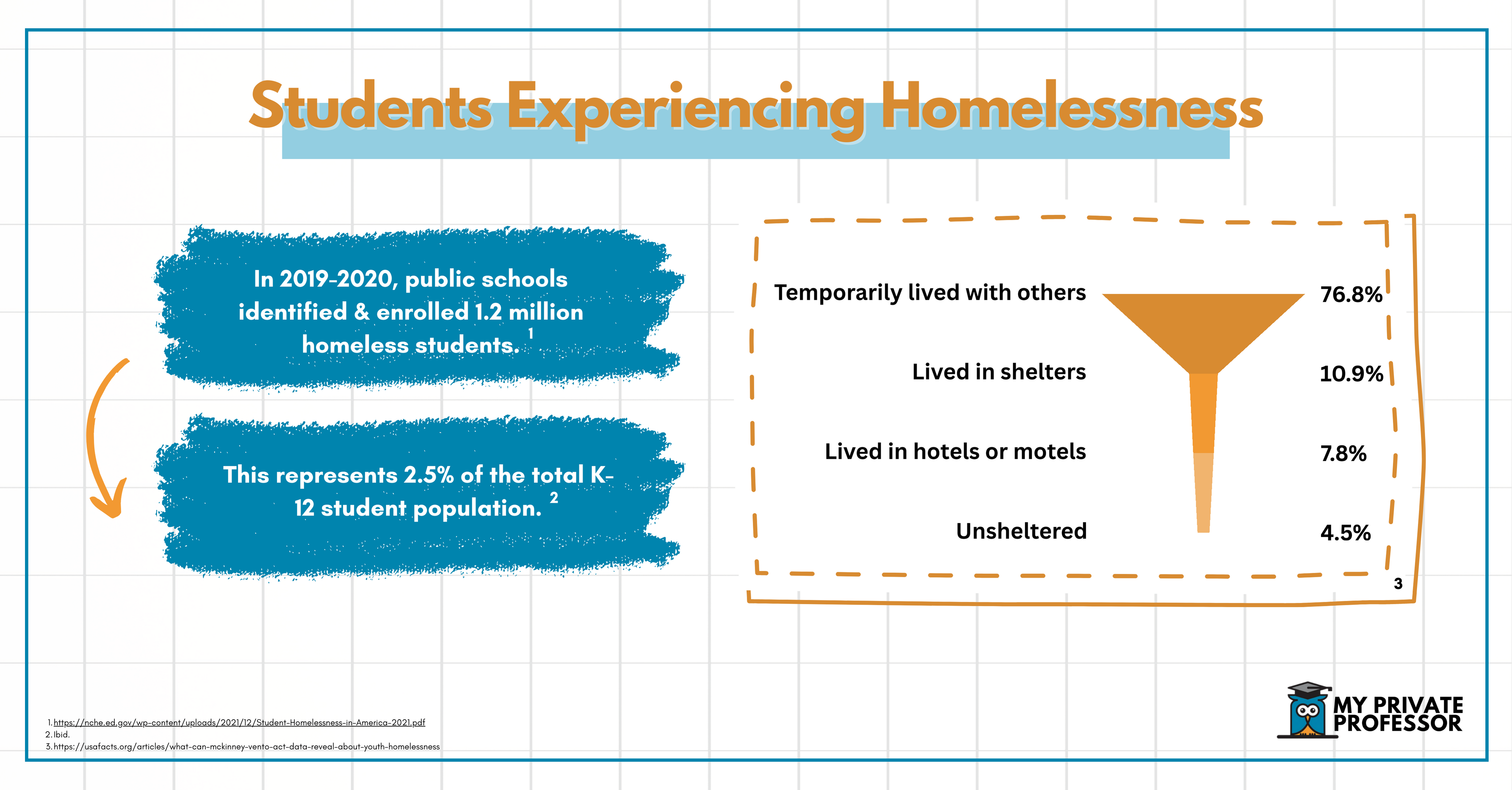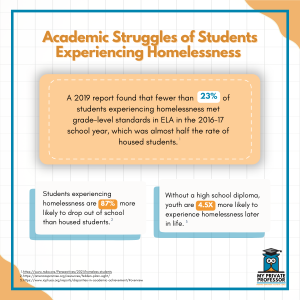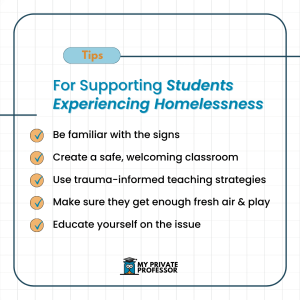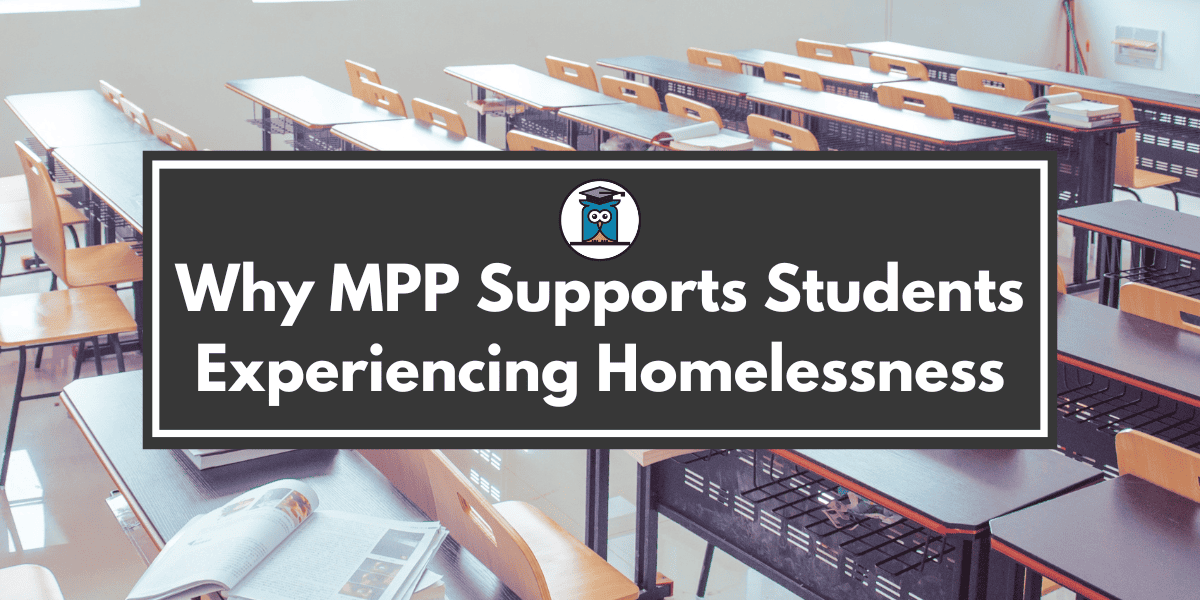As humans, we often seek certainty. Really, we tend to bask in the comfort of knowing what’s to come.
That’s why, after a long, whirlwind day of your first job, you might be more than ready to put on your comfiest sweats, order in your favorite foods, and put on that timeless movie (for which you can admittedly recite more than a few scenes by heart).
It can be easy to take for granted the fact that you do actually have a lot of comfort and certainty in your life that you can turn to when things seem crazy. For instance, as a student, some days you may feel stressed all day because you have a bunch of exams—and you don’t really know how they’re going to go.
But after the day is done, you can probably go home and indulge in all your self-care activities. 
But for some people, such as students experiencing homelessness, it’s not that simple.
How common is homelessness amongst students?
In January 2020, the Department of Housing and Urban Development reported that 106,000+ children were homeless; 11,000 of whom were living outside.
Yet, this is likely an underrepresentation due to the ways in which students experiencing homelessness are undercounted.
Homelessness and student mental health
Significantly, mental health struggles and substance abuse are markedly higher among students experiencing homelessness than their peers. These students are more at risk for experiencing rape, assault, suicide, substance abuse, hunger, and bullying, according to School House Connection.
Unsurprisingly, not having a stable housing situation can wreak havoc on students’ mental health. In turn, this diminishes students’ ability to show up and perform to their highest potential.
In a 2016-2017 survey addressing youth homelessness, sixty-nine percent of youth experiencing homelessness reported having mental health difficulties.
As research shows, mental health concerns can negatively impact students’ academic progress by causing concentration difficulties, problem solving difficulties, fatigue, and recall difficulties.
When we hold onto emotional struggles or chronic stress, we tend to act out. Or lash out. And students experiencing homelessness are no exception.
As a result of the anxiety and stress they may feel, it’s common for students experiencing homelessness to exhibit behavioral/emotional issues. And as a result, they are three times as likely to be suspended from school than housed students.
This seems counterproductive—these are students who already face major issues and are more likely to have attendance issues than housed students. So instead, it seems that schools should be providing more emotional support and guidance to students experiencing homelessness. 
Homelessness and physical health
As the National Health Care for the Homeless Council points out, living either on the street or in a crowded homeless shelter is stressful—that by itself can lead to higher risk of illness. That is, chronic stress is directly linked to a number of health issues—even death.
On top of that, this type of living situation can expose students to transmissible illnesses such as TB, respiratory illnesses, flu, and hepatitis. Additionally, malnutrition and harmful weather can also lead to illness.
In addition, students who are experiencing homelessness may not have access to sufficient sources of healthy food. And research long demonstrates that healthy eating is directly linked to academic performance. And specifically, that when students aren’t getting the proper nutrients, they can’t properly learn.
Meanwhile, even if students can get access to medical treatments, uninhabitable conditions can make it extremely difficult to recover and maintain good health.
The result here is that students are less able to focus on their school work. That is, if they can even show up to school. Unfortunately, this risk of physical illness makes it more difficult for students to attend. And of course, this lowers the chance of these students graduating and moving on to higher education.
Academic struggles of students experiencing homelessness
When students don’t know where they’re sleeping on any given night, or if they’ll even be able to find shelter, they face major challenges in succeeding in school. For these students, there’s so much uncertainty on any given day—so they likely spend a lot of their time and energy worrying about and figuring out whether or not they’ll have a roof over their head.
Research has long suggested that youth experiencing foster care can experience major academic setbacks due to educational instability. According to research, youth experiencing homelessness are chronically absent at least twice as much as their peers were.
Uncertainty breeds fear and stress, which are two major roadblocks to academic success. If children are holding onto this uncertainty, it can be near impossible to maintain focus and retain class material. 
Homeless students, nationally, graduate from high school at lower rates than their non-homeless peers. In the 2018-2019 school year, the average graduation rate for students experiencing homelessness was almost seventy percent, which is almost eighteen percent below all students.
Supporting homeless students in your classrooms
Considering how students experiencing homelessness are often undercounted, it’s important to recognize signs in order to identify and better support these students. Significantly, research shows that academic performance and attendance stabilize after students are identified as both homeless and eligible for support services for multiple years.
Thus, it’s critical to be aware of signs that students may be suffering due to unstable housing.
Signs that students are experiencing unstable housing
As noted, it’s important to recognize way in which the reported number of students experiencing homelessness is typically inaccurate.
For many students, an unstable housing situation might be something which causes them feelings of shame or embarrassment. As a result, they may have difficulty reaching out to their teachers or supporting people at school.
So as educators, it’s vital to recognize signs that a student may be facing unstable housing, including:
- Academic difficulties
- Social/behavioral issues
- Poor health/hygiene and nutrition
- Unexplained absences
- Inability to complete assignments/projects
- Avoidance of discussing personal details
- Lack of parental involvement/support
How can teachers support students experiencing homelessness?
Implement trauma-informed practices. Whether it’s due to their current housing situation, or how they came to be in their current situation, students experiencing homelessness may be holding onto trauma. Research shows that trauma can impede learning, so it’s critical for educators to learn about and adopt trauma-informed teaching strategies.
Encourage in-school counseling. Students experiencing homelessness may be dealing with a ton of pent up stress and anxiety on any given day. Having a supportive figure around who they can talk with can help these students feel heard and less alone.
Have regular check-ins. As noted, students may have a difficult time opening up, even if they are keeping a lot inside. When you take the initiative to hold regular check-ins, you’ll make it a lot easier for the student to share. 
Promote stability in the classroom. Students experiencing homelessness may be constantly dealing with various forms of uncertainty (food sources, support systems, health), so it’s incredibly important to cultivate an environment that maintains as much stability as possible.
Craft a morning and afternoon routine to which students can become accustomed. Plan ahead, ensure students know what’s coming up, and post your monthly calendar up in the classroom.
Respect student privacy. Students may very well want to keep the details about their unstable housing situation to themselves. Respect this. If you don’t, you’ll likely end up losing the student’s trust.
Provide alternative assignments. If you know there’s a student (or students) in your classroom with an unstable housing situation, plan to offer alternative assignments. For instance, students experiencing homelessness may not be able to complete an assignment based on a live TV episode or an assignment requiring transportation.
Provide sufficient time for play. Since school may be the only place where students experiencing homelessness can enjoy both structured and unstructured play, make sure you provide this regularly. Having sufficient time for recess is critical to any child’s day-to-day school experience. For students who experience housing instability, this seems to be even more important.
Final thoughts
At My Private Professor, we’ve done the research. We see the numbers. So we know that students experiencing homelessness and/or in long-term foster care (LTFC) face unique obstacles when it comes to getting the academic support they need to succeed.
That’s why, through our business model, we prioritize giving back to this group of students. Our Give-Back model allows us to earmark net proceeds from EVERY tutoring hour, which we use to provide students experiencing homelessness and/or in LTFC with free tutoring hours.
We’re so grateful to work with incredible nonprofit organizations who help us carry out our mission. This includes Illumination Foundation, which aims to disrupt the homelessness cycle in Southern California, and SAHARA, which seeks to support and empower victims of abuse and their families.







